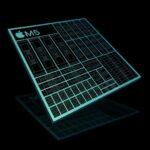Apple’s unveiling of the M5 chip in the latest MacBook Pro and iPad Pro models marks a significant evolution in its in-house silicon lineup. Building on the strong foundation laid by the M4, the M5 delivers notable improvements, especially in graphics processing, AI capabilities, and overall performance efficiency. We tested the new M5 chip against its predecessor to uncover the concrete benefits for users, particularly creatives and professionals relying on heavy computational workloads.
Enhanced CPU and Multithreaded Power
The Apple M5 retains a similar 10-core configuration as the M4, comprising 4 high-performance cores and 6 efficiency cores. However, architectural refinements and clock speed increases (up to approximately 4.61 GHz) provide around 15% faster multithreaded CPU performance than the M4. This improvement sustains smooth multitasking and accelerates demanding creative workflows such as video editing and software development.
Next-Generation GPU with Ray Tracing
One of the most eye-catching upgrades with the M5 is its graphics processing unit. It continues with a 10-core GPU architecture but integrates a dedicated Neural Accelerator in each core. This new setup delivers up to 45% faster graphics performance and over 4 times the peak GPU compute power for AI workloads compared to the M4. Additionally, hardware-accelerated third-generation ray tracing capabilities allow more photorealistic lighting, reflections, and shadows, enhancing the visual fidelity in games and 3D applications on both MacBook Pro and iPad Pro.
Powerful Neural Engine for AI Tasks
The M5 features an upgraded 16-core Neural Engine, making it substantially more capable in AI-related tasks than the M4. Benchmarks indicate a roughly 3.5 times increase in AI performance, greatly benefiting applications involving machine learning, real-time video enhancement, and even running local large language models. For professionals working on AI-driven creative and computational tasks, this means significant speed and efficiency gains.
Improved Unified Memory and Thermal Design
Memory bandwidth has been boosted to about 153 GB/s from the M4’s 120 GB/s. This roughly 30% increase in unified memory bandwidth facilitates smoother handling of large datasets, complex 3D scenes, and intensive multitasking. Despite the higher performance profile, the M5 chip’s thermal management remains robust within the same MacBook Pro architecture. It does require higher sustained fan speeds to maintain peak performance under heavy load, but Apple has balanced these needs to maintain comparable battery life to the M4 models.
Real-World Performance and Value
In practical use testing, the M5 MacBook Pro and iPad Pro complete CPU-heavy and GPU-intensive tasks significantly faster than their M4 counterparts—sometimes by margins exceeding 30%. Video transcoding, 3D rendering, and AI-enhanced workflows all see noticeable boosts. The M5-powered devices start at similar price points to those with M4 chips, offering users a compelling upgrade path without additional cost.
In summary, the Apple M5 chip delivers a marked advancement over the M4, particularly in graphics speeds, AI capability, and sustained performance, while maintaining efficient power usage and a familiar design. For creatives, professionals, and tech enthusiasts, the M5-based MacBook Pro and iPad Pro represent a meaningful leap in the capabilities of Apple’s silicon that justifies the upgrade.






